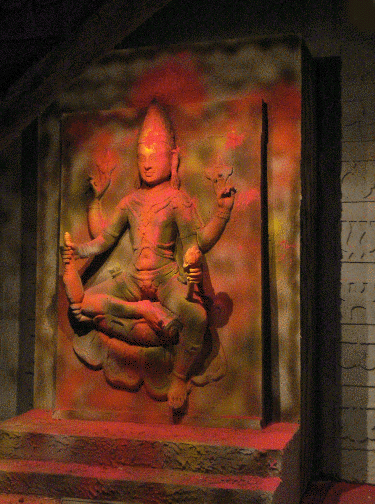
|
|
|
|
BY: RABINARAYAN PANI

Maa Hingula Dec 09, 2010 — BHUBANESWAR, ORISSA (SUN) — Gopalprasad is a big village, situated at a distance of about 35 kms from Talcher, the coal hub of Angul district. The famous festival of the presiding deity of the erstwhile Talcher Kingdom - Maa Hingula or the "Goddess of Fire" - is observed every year during April-May at Gopalprasad. The area is surrounded by coal mines. With a long cultural legacy, the festival is unique. Thousands of devotees, most of them clad in typical ochre robes, congregate here for the 9 day long festival. Rituals of tribals and the Sakti cult are performed at Maa Hingula's festival. The pageant of the goddess in three small pillars is taken out by a horde of priests, accompanied by a huge congregation of devotees amidst the sounding of conch, bells, cymbals, drums, pipes and chanting of mantras. The goddess is worshipped at two sites, one in the temple and the other on a raised platform with a big appliqué atop, tied to four wooden poles around. The platform is fenced off. On the platform, a heap of coal is set on fire. The fire represents the goddess. The devotees, after having darshan of Goddess Hingula in her temple, return to worship her at the fire, where on Sukla Chaturdasi of Chaitra month, the goddess gives darshan to devotees in the form of Burning Fire. Coconuts, ghee, milk, cheese, special bhog, clothes, vermillion, sandalwood paste, bangles and cowrie, etc. are being offered by the devotees. These offerings are thrown into the raising flames. At a nearby site, thousands of kids sit in tandem and a handful of barbers save their heads. Hingula Yatra has a long history. The Goddess Hingula is worshipped both inside and outside the temple by the people, once every year in April. The ex-king of Talcher was the great patron of this festival. In case there was any trouble in his kingdom like disease or war, the king was praying the goddess to save his kingdom and the people. Special villages have granted lands for funding the festival. The yatra starts and moves on with the Jantala Puja, Putabari Utshava and culminates with Sital Yatra. According to legend, once Dakhya Prajapati, the father-in-law of Lord Shiva, was organising a ceremony of sacrifice (yagnya). He had invited many gods, goddesses, kings of repute, saints and seers to attend the ceremony. However, he did not care to invite his daughter Parvati (Sati) and son-in-law Shiva. Knowing about the celebration of yagnya, Parvati pleaded with Shiva to go to her paternal home. Shiva however denied her on the ground that she had not been invited. Despite her husband's denial, Parvati attended the ceremony. At the ceremony site she was laughed at for having married to a nude man, living in graveyard. Parvati, being unable to bear humiliation of her revered husband, threw herself in the flames of the yagnya and killed herself. When Shiva got this news, raged in anger he dashed off Prajapati's palace. He recovered the half burnt body of Parvati from the fire and was about to kill everybody there and destroy the whole creation. Awestruck, the other gods went to the palace of Lord Vishnu, asking Him to come to their rescue. Vishnu could know that the sight of the dead body of Parvati was fueling the anger of Shiva and ordered his Chakra to destroy the body. The weapon cut the body into 51 pieces. Wherever each piece fell down, there Mother Goddess appeared in one name or the other. Goddess Hingula is one of the 51 forms of the Goddess. Sarala, Bimala, Biraja, Bhairabi, Tareni, Mangala, and Budhi Thakurani, to name but a few, are manifestations of the Goddess found in the Udra country. This is the origin of Goddess Hingula at Talcher. According to another legend, after the construction of Lord Jagannath Temple was finished at Puri, Lord Jagannath ordered King Indradyumna to bring Goddess Hingula from Bidarbha to Puri to cook His Mahaprasad. Raja Indradyumna requested the King of Bidarbha to bring the Goddess to Puri. Meanwhile, the Bidarbha king Ramananda was also given the divine instructions to shift the Goddess to Puri. King Ramananda was bringing the Goddess on his shoulder by covering her with a cloth. At Gopalprasad, Ramananda felt thirsty, brought Hingula down and went to a nearby pond to take water. When he returned, he found that the Goddess had vanished. When the king cursed himself, the Goddess appeared before him and told him to establish a temple for her there, and she wanted to cook Mahaprasad for Lord Jagannath from there. The fire used to cook the Mahaprasad in the kitchen of the Jagannath Temple at Puri represents Maa Hingula. The worship of Maa Hingula represents a mixture of tribal worship and Sakta Cult. The earlier practice of animal sacrifice is no more. Now only vegetable and sweets are offered as bhog. Hingula represents fire and every year appears in the form of flame at different places. The festival of Maa Hingula ends with Sital Yatra.
| |